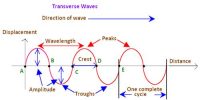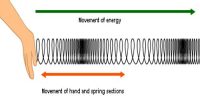Difference between longitudinal and transverse wave is:
- When the motion the particles of the medium are parallel to the direction of propagation of the wave, the wave is called a longitudinal wave.
- Compression and rarefaction are occurred.
- The particles of the medium are parallel to the direction of propagation of the wave.
- This wave is produced in solid, liquid and gases.
- This wave has no polarization.
- When the motion of the particles of the medium is perpendicular to the direction of propagation of the wave, the wave is called a transverse wave.
- Crest and trough have occurred.
- The particles of the medium are perpendicular to the direction of the propagation of the wave.
- This wave is produced in solid. In fluid due to surface tension transverse wave may be produced.
- This wave has polarization.















